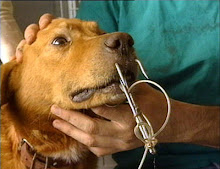
Photo: Business Wire
FDA Approves First and Only Single-Dose Antibiotic for Dogs and Cats
Pfizer’s New Prescription-Only Convenia® Eliminates Difficulty Owners Have Giving Pills to Pets for Weeks
NEW YORK--(BUSINESS WIRE)--Pfizer Animal Health has announced the Food and Drug Administration (FDA) has approved Convenia® (cefovecin sodium), the first and only antibiotic for dogs and cats available in a single veterinarian-administered injectable dose.
Convenia provides up to 14 days of antibiotic treatment in a single dose for the most common skin infections in dogs and cats – the No. 1 reason pets are prescribed antibiotics.1
By relieving pet owners of the often impractical responsibility of giving pills to their pets several times a day for weeks at a time, Convenia ensures the antibiotic course of treatment is completed on time, giving the pet the best chance for treatment success.
“We understand how difficult it can be for owners to give their pets the right pills at the right time. With career and family responsibilities, many people simply aren’t around at appropriate intervals once, twice or even more times a day despite their best intentions,” said George Fennell, vice president, Companion Animal Division, Pfizer Animal Health. “With Convenia, the pet gets the dose it needs right in the veterinarian’s office – so owners don’t have to worry about when and how to give pills to their pets.”
The third in a string of new companion animal products in 15 months – following the approvals of the first canine obesity medication and the first veterinary drug to control vomiting in dogs, both in early 2007 – Convenia represents yet another first from Pfizer Animal Health. Convenia is now available at veterinary practices nationwide.
‘Pilling’ is a Challenging Responsibility for Pet Owners
Antibiotics currently in use for dogs and cats, while generally effective, can be challenging for owners to give due to the need for daily or twice daily oral doses over several weeks. Besides busy lifestyles that often don’t allow owners to be physically present to give their pets oral medications at the right times, owners often forget to give pills and they prematurely end therapy when their pets start to look or act better.
Some pet owners report that pets resist “pilling” or other orally administered medications. Research shows that 30 percent of dog owners have trouble pilling their dogs, while cat owners rank pilling as one of the most stressful activities involved with caring for their cats.2
When doses are not given on time or when they are missed or stopped prematurely, pets do not receive optimal treatment and risk treatment failure, deterioration of health, and additional veterinary visits. Veterinarians report that non-compliance is the major cause of treatment failures and/or relapses in antibiotic therapy.3
“The approval of Convenia, the first in its class, marks a significant milestone in the effective administration of antibiotics for companion animals,” said Amy Trettien, DVM, Pfizer Animal Health. “For the first time, we may be able to see what 100 percent antibiotic compliance looks like.”
Full Course of Antibiotic Treatment
Skin infections, which are caused by a variety of bacterial pathogens, are the No. 1 reason dogs and cats receive antibiotic treatment.1 In dogs, skin infections are typically a response to an allergy or parasite infestations that result in scratching, licking and biting behavior that can weaken skin and make it susceptible to bacterial infections. In cats, skin infections are typically in response to wounds or bites that become infected.
In U.S. clinical trials with 26 veterinary clinics, Convenia was proven to be statistically equivalent to a 14-day course of antibiotics with a veterinary-labeled, multi-day oral cephalosporin antibiotic. Study results showed that, in most cases, a single dose of Convenia was effective against naturally occurring skin infections in dogs and cats. Treatment outcomes for both dogs and cats were as effective as the oral antibiotic used in the study. In most cases, only a single injection was necessary. Only 14 percent of treated canines required a second dose of Convenia to complete treatment.
Convenia is well tolerated, and its safety has been demonstrated in adult dogs and cats as well as in puppies and kittens. The most common side effects seen with Convenia are similar to those seen with other antibiotics, vomiting, diarrhea, decreased appetite and lethargy. More than 4 million doses of Convenia have been administered to pets globally since 2006.
For full prescribing information about Convenia, visit www.convenia.com.
About Pfizer Animal Health
Pfizer Inc (NYSE: PFE), the world’s largest research-based pharmaceutical company, also is a world leader in discovering and developing innovative animal vaccines and prescription medicines. Pfizer Animal Health is dedicated to helping companion animals live longer and healthier lives and to the safety and productivity of the world’s food supply by enhancing the health of livestock and poultry. For additional information on Pfizer’s portfolio of animal health products, go to www.PfizerAH.com.
1 Confidential PAH Market Research/2003/*US Diary Study Wave 1, 2, 3, 4 and 5 and MDI data
2 Convenia Pilling Study, Jan. 2008 by Forward Research
3 Pfizer Animal Health Market Research, 2005
SKIN INFECTIONS IN DOGS AND CATS FACT SHEET
How common are skin infections in dogs and cats?
Skin infections are the No. 1 reason pets are prescribed antibiotics.¹ Common skin infections include pyoderma (literally, “pus in the skin”), wounds and abscesses. For cats, abscesses and wounds are more common.
What are the causes of skin infections?
Skin infections are caused by a variety of bacterial pathogens, the most common being Staphylococcus intermedius. In dogs, skin infections typically occur in association with an allergy or parasite infestation that causes the animal to scratch, lick, and bite the affected area. This reaction can weaken the skin and disrupt the skin’s natural defense mechanisms, making it susceptible to bacterial infections. In cats, skin infections more commonly occur after the animal sustains a trauma or bite.
Pyodermas in dogs are classified by the depth of the infection. Superficial pyodermas affect the top layers of skin, while deep pyodermas involve the deeper layers of skin, and commonly extend beneath the hair follicle.
Less commonly, skin infections may be secondary to a hormonal disease, such as Cushing’s disease or hypothyroidism, or other diseases that suppress the immune system.
How can you spot skin infections?
Since skin infections are generally secondary to underlying skin problems including allergies and parasite infections, pet owners may first notice certain behaviors that indicate a problem. For dogs that might include biting or chewing areas like the top of the tail or legs; closer examination might reveal broken hairs, a rash-like appearance, red pustules and patches of thickened skin that may look darker than the surrounding skin. Cats will sometimes appear to be itchy, especially around their head and ears, and scratch these areas.
How are skin infections treated?
Skin infections in both dogs and cats are generally treated with systemic antibiotics. For superficial infections, antibiotics are generally administered for 14-21 days. For deeper, more severe infections, treatment can last eight weeks or even longer.
Along with oral antibiotics, veterinarians may also recommend an antiseptic shampoo and if the primary disease that led to skin infection can be determined (for example, allergies or a parasite infection like fleas), treatment of the underlying problem.
Are skin infections difficult to treat?
While antibiotics currently used to treat skin infections in dogs and cats are generally effective, treatment can prove difficult for some owners, generally because the treatment is administered at home over a long period of time. Some common challenges include:
• Scheduling: Antibiotic therapies usually require dosing at regular intervals over an extended period of time, generally twice a day at 12-hour intervals. Some owners, due to scheduling issues and other demands on time, occasionally have difficulty administering the correct dose in the proper timeframe, especially when the treatment period is of long duration.
• Stopping therapy too soon: Some owners, once their pet begins to heal, stop treatment early, or skip or forget to administer the antibiotic. This can lead to less than optimal treatment, and put the pet at risk of treatment failure. Skin infections, although sometimes appearing to be cured, can persist under the skin or in small pockets that might not be easily seen by the owner.
• Pilling: Most antibiotics in the market are administered orally, which can prove stressful and challenging with some pets. Research indicates that 30 percent of dog owners have trouble pilling their pets, while cat owners rank pilling as one of the most stressful activities involved with caring for their cats.2
What are the long-term implications for skin infections?
Untreated skin infections can adversely effect a pet’s quality of life and often, the relationship between owner and pet. Non-compliance with antibiotic treatment can contribute to a failure to cure the condition, a prolonged disease process, recurring infection, deteriorating health, and the need for additional visits to the veterinarian.
1Confidential PAH Market Research/2003/*US Diary Study Wave 1, 2, 3, 4 and 5 and MDI data
2Pfizer Animal Health Market Research, 2005
Contacts
For Pfizer Animal Health
Sara Coulter, 201-447-5531
scoulter@tagteamglobal.com
or
Rick Goulart, 212-733-7457
rick.goulart@pfizer.com

















1 comment:
Thank you so much for sharing this informative blog. I got some tips to maintain my pet healthy and active. Anyway if you want to have a lots of information about Convenia Get information here
Post a Comment